The start of the Libertadores showcased what many in Argentina had already begun to see; Estudiantes have been one of the best teams in South America. Nearly halfway into the 2022 season, Ricardo Zielinski’s team have only lost two matches and currently sit top of both their Libertadores and Copa de la Liga groups. After the fourth matchday of the Libertadores, Estudiantes are the only team to have qualified for the next round along with Palmeiras.
Without many stars and nowhere near the quality of the likes of River Plate, Flamengo, and Palmeiras, Estudiantes have still been able to perform extremely well. Zielinski’s rather unique tactics have seen them exceed expectations and become one of the leading teams in South America. This tactical analysis examines the tactics used by Ricardo Zielinski throughout different phases of the game. In addition, we look at not only why they have been successful, but also how they look ahead of bigger matches and challenges.
Formations
Despite the very tough South American schedule, Zielinski has been rather consistent with his lineups. Although certain pieces rotate, there are a core group of players who have constantly featured. In April’s 30 days, Estudiantes played a total of nine matches. That averages out to nearly a match every three days. This exhausting schedule automatically begs the question: how will they arrive in the latter stages of the Libertadores fitness-wise?
A few core pieces have constantly featured for Estudiantes lately. A backline of Godoy, Rogel, Noguera, and Mas has been very consistent, especially due to the fullbacks’ attacking characteristics. Further up, Zuqui and Rodríguez have been the backbone of the midfield. Finally, 36-year-old Boselli has constantly featured despite his old age.
As far as formations, a 4-4-2 has been the go-to structure. Within matches and even phases of the game, Zielinski has also varied with a back three. In addition, the structure of the more advanced players will change based on the characteristics of the player, although a core organisation is maintained.
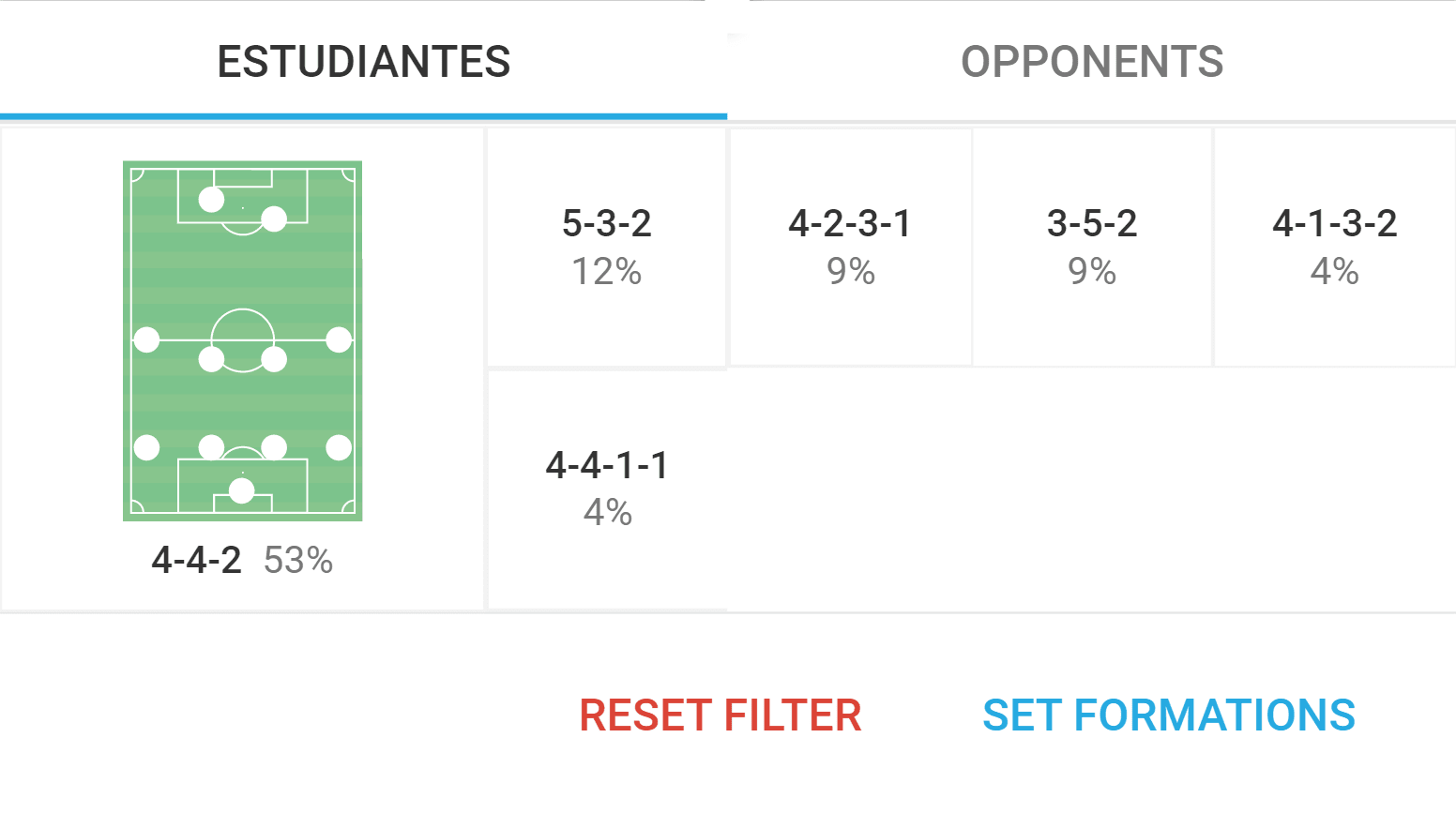
Build up
Ricardo Zielinski’s side has rather unique tactics. They only average 46.67% of possession and a low 313.04 passes per 90. Additionally, they average 2.74 passes per possession and have the lowest passing rate in the Copa de la Liga with 11.1 passes per minute of possession. Finally, 17.26% of their passes are long passes, a relatively high number. Despite these metrics, Estudiantes have the highest xG per shot in the Copa de la Liga with 0.135. They are still able to create extremely valuable chances without a very controlled approach to possession. Tactically, Zielinski’s side also maintains a very good organisation as we will see throughout the multiple phases of possession.
Despite setting up in a 4-4-2, Estudiantes prefer to build with a single pivot. One of the midfielders will drop in while the other sits higher. Other players such as a false-nine or inside forwards will drop in to provide options. The centre-backs sit wide while the fullbacks push high and wide.
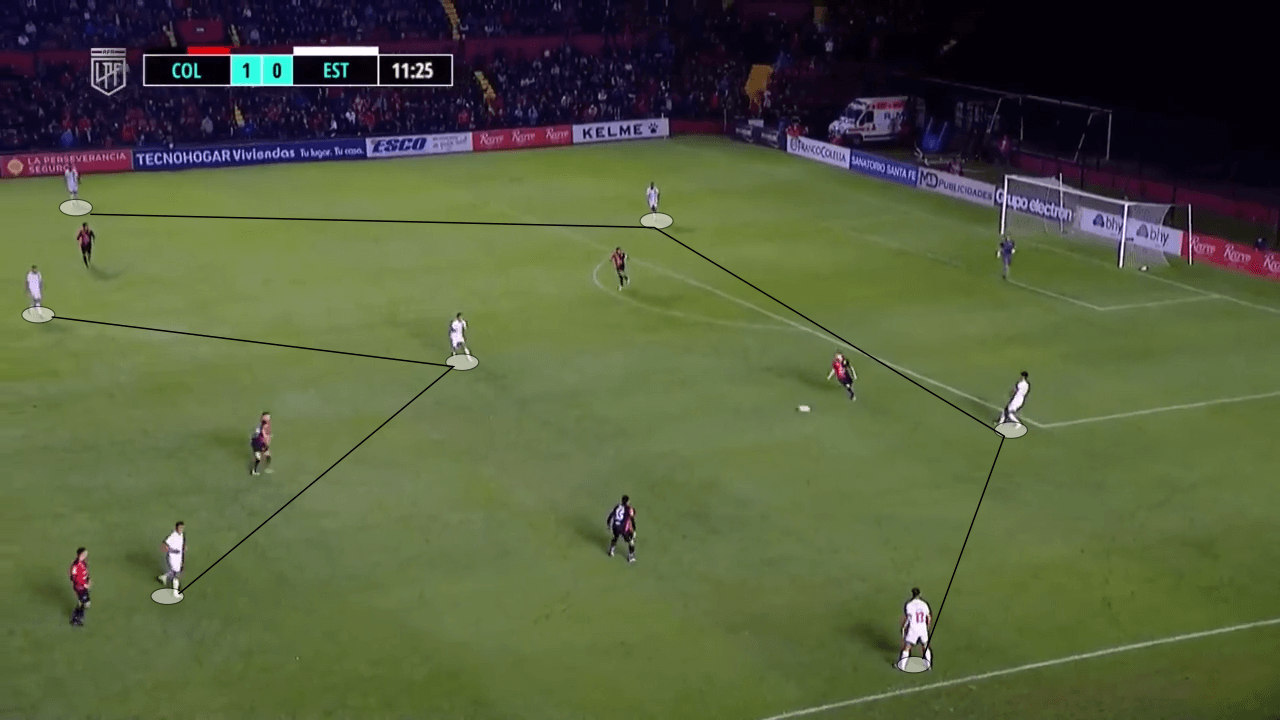
The role of this single pivot is very important as he is usually the main man in construction. His movement behind the first line of pressure is key in progressing forward. He must also be able to receive and quickly move it along. In the image below, we are able to see his movement to check in behind the first line of pressure.

Traditionally, a team with a single pivot aims to construct through the middle. A single midfielder deeper means there will be higher numbers further up the pitch, and they are key in progressing to the next phase. As they move further up the pitch, we are able to see how narrow their structure is. The two wide players significantly drift inside, allowing the fullbacks to provide the width.
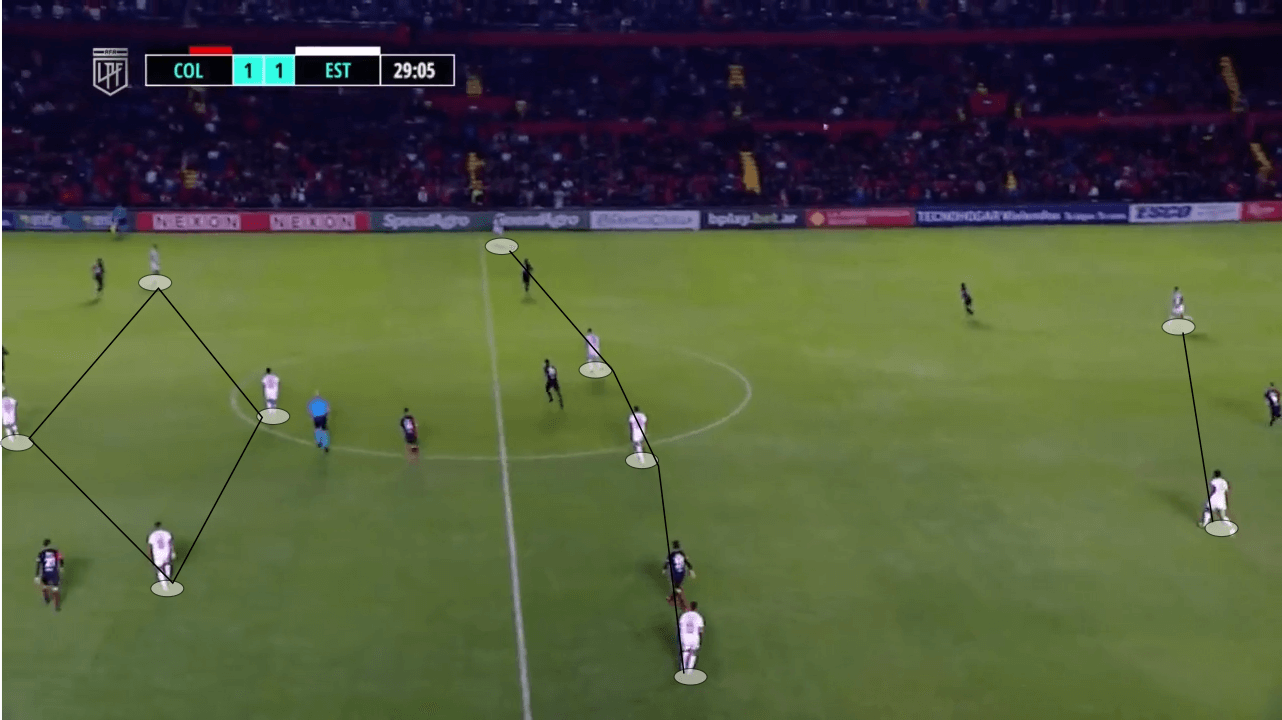
Zielinski’s approach both organisationally and behaviourally essentially depends on approximation. Estudiantes aim to break lines quickly and through the middle. Especially in the build-up, players from further up the pitch are constantly presenting themselves and providing options. Normally, they are also very close to one another, allowing for quick combinations before advancing it further. In the example below, we see how the left-winger drops inside to receive the ball, almost forming a midfield trio with the other two midfielders.
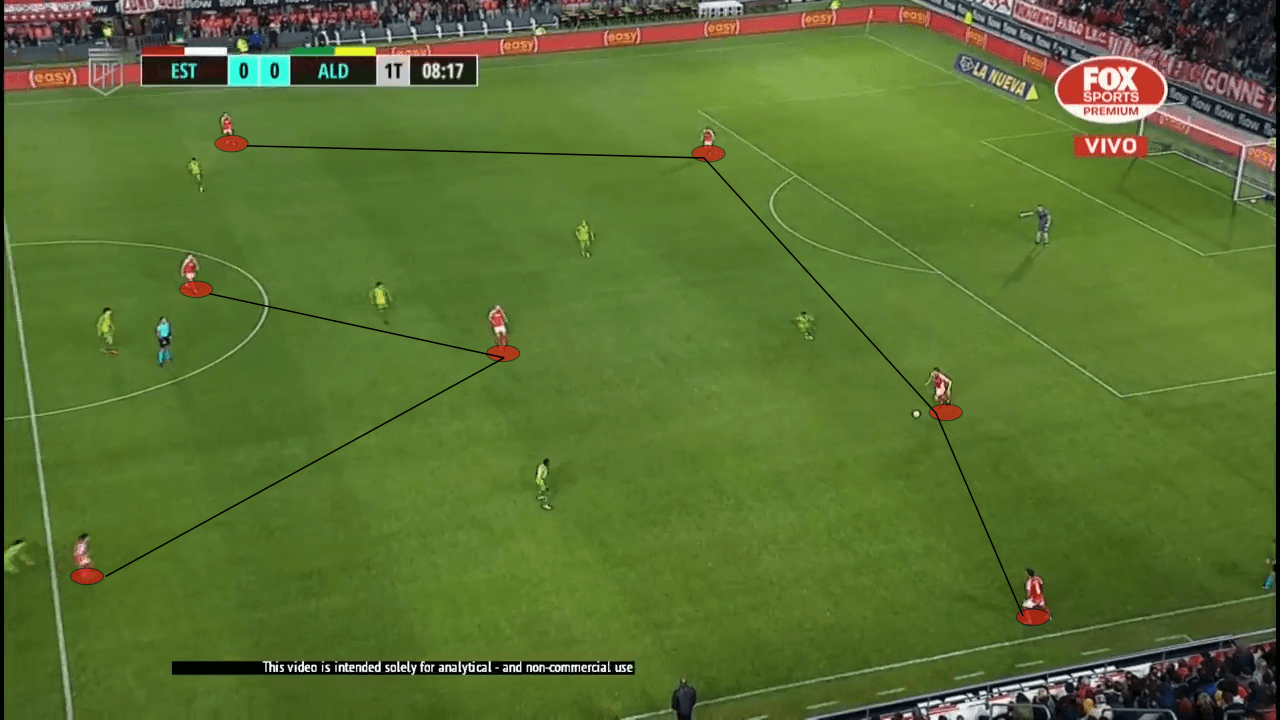
A variation with three at the back is also fairly common. This can be done in various ways, but the primary goal of this variation is to enhance the fullbacks’ role in the attack. They are allowed to push up higher and stretch the pitch. Consequently, the third man at the back is often one of the midfielders.
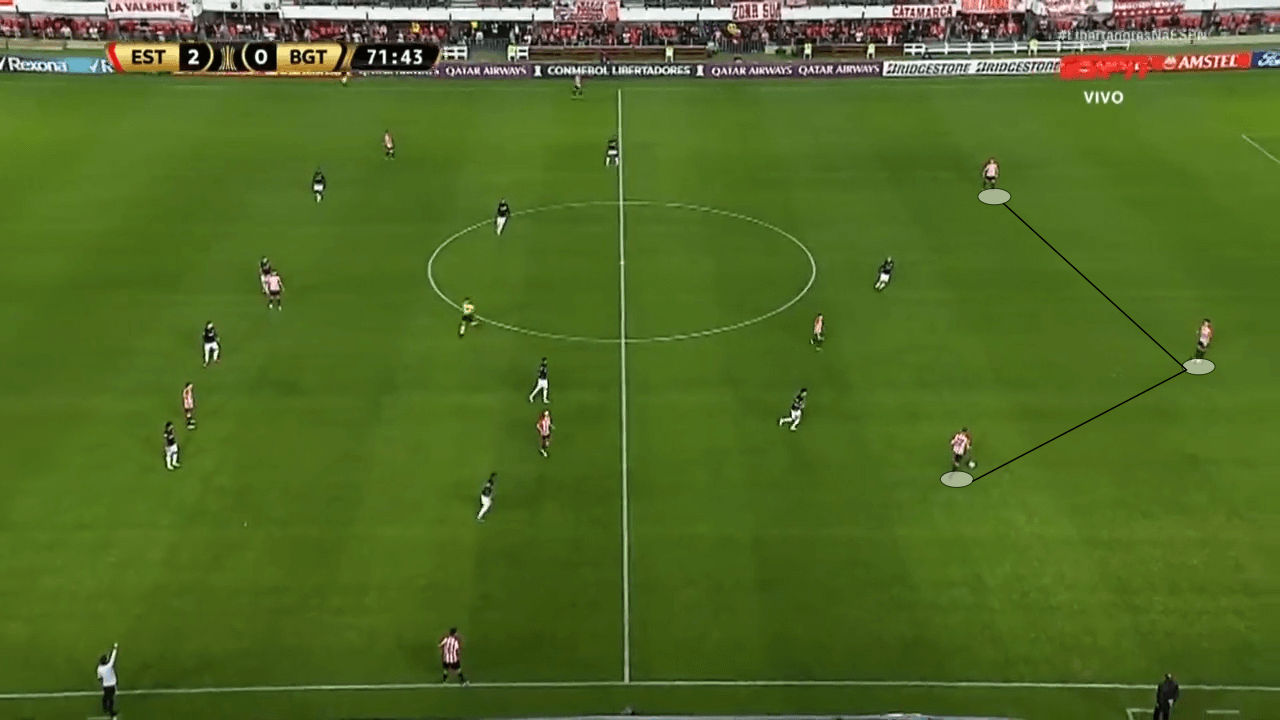
The segment below further illustrates this concept. As they look to construct play against Tigres, the centre-back moves the ball further up the pitch.
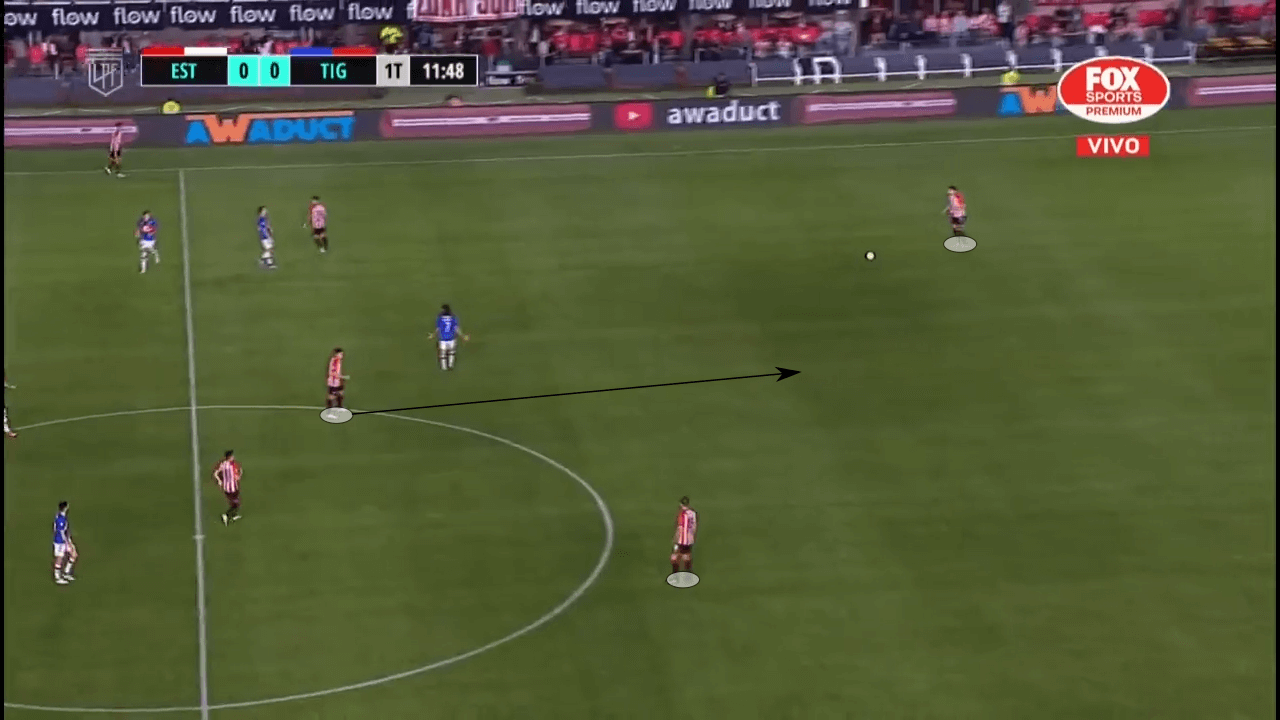
One of the two midfielders drops in between the two centre-backs and immediately gets on the ball. Estudiantes’ midfielders are very good playmakers and provide additional quality in the construction.
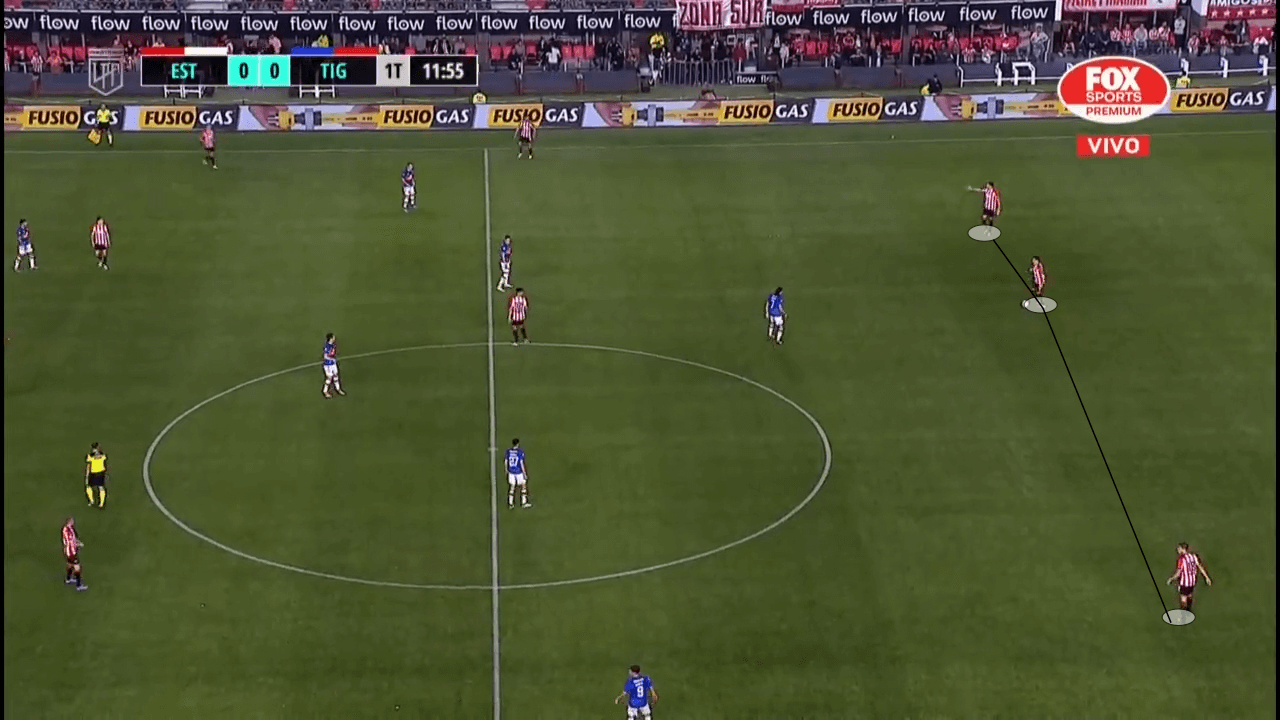
Progression
As they progress to the next phase of possession, Estudiantes maintain very similar principles and patterns of behaviour. They still aim to break lines with frequency and constantly attack the depth. The role of each position is crucial in this, and the few variations used make them very dynamic.
The first key characteristic of Estudiantes’ attack is the role of the fullbacks. Both are very involved in the attack and play a key role in providing width and attacking the depth. This concept can be illustrated in the segment below. As they progress closer to the final third, the left-back immediately sprints forward to attack the depth in the wide channel. Notice how only one player occupies the wide channel at a time, usually the fullbacks.
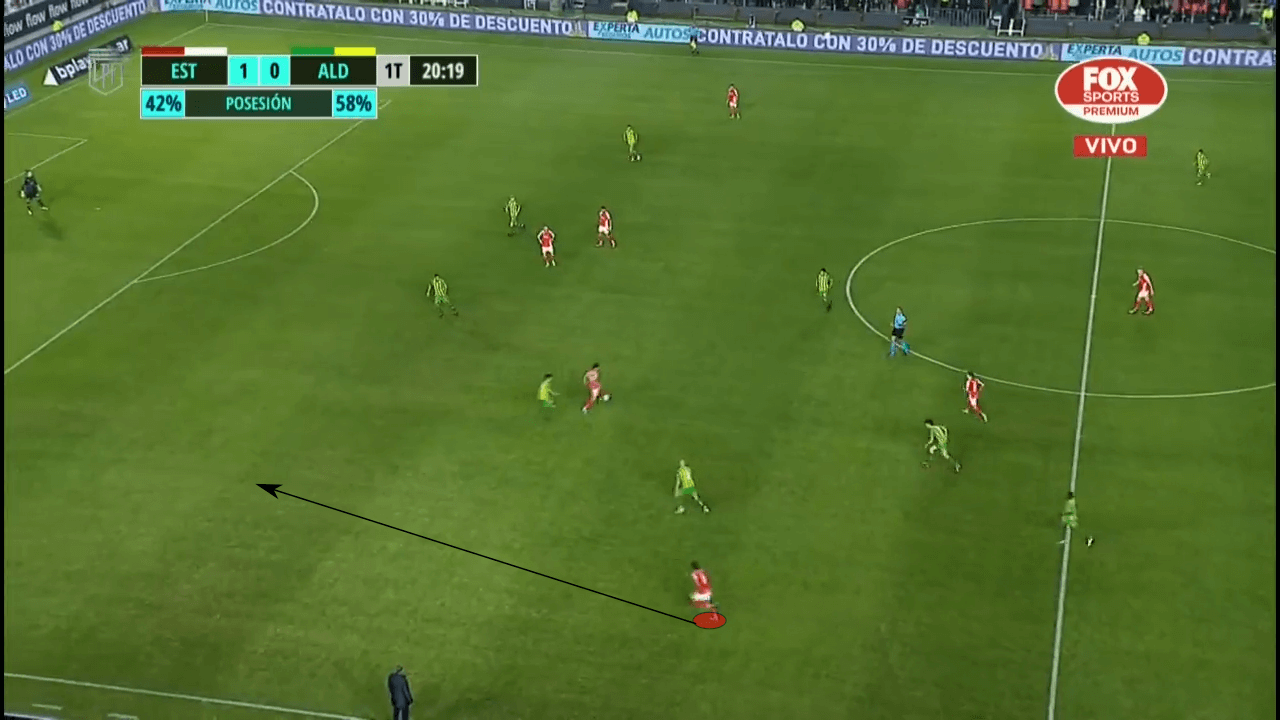
Despite the left-back’s run, they switch it to the other side. As they move it across, the right-back begins to advance into the final third. The right-winger immediately checks into the half-space, leaving the wide channel completely unoccupied for the right-back.
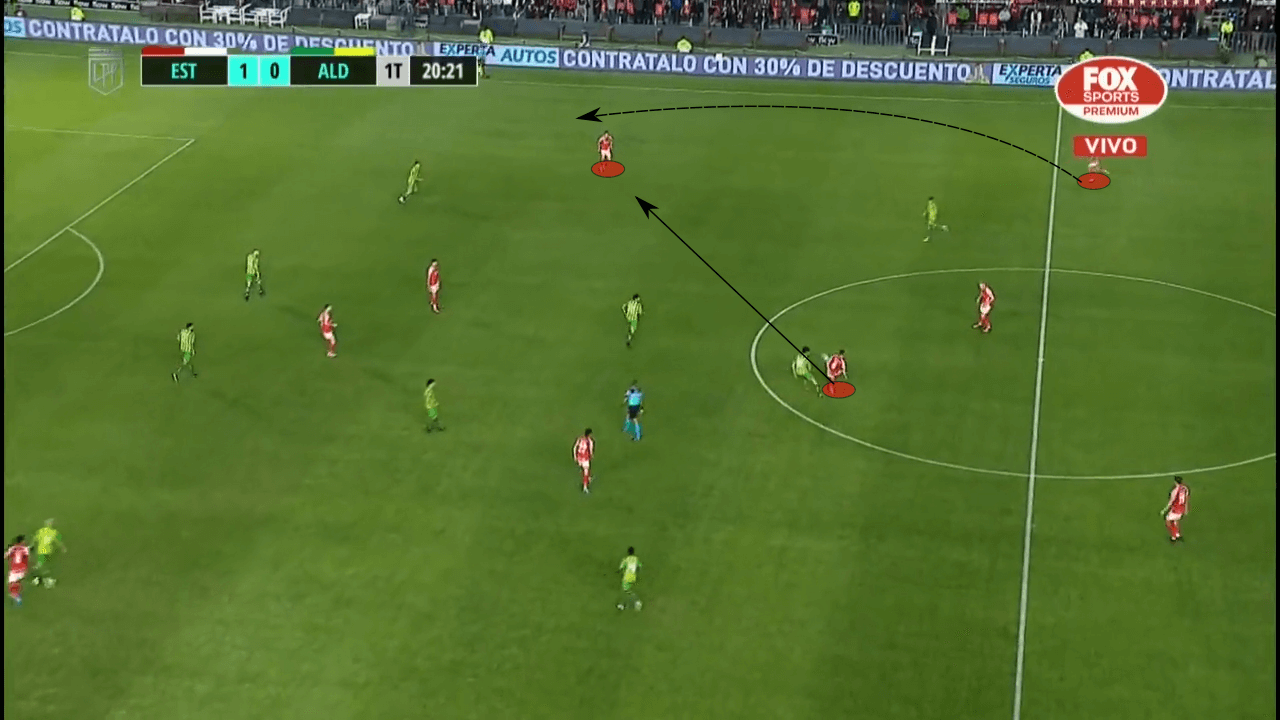
By the time the right-winger receives the ball, the right-back is already overlapping him. This overlap forces the defender to make a decision between him or the right-back. In addition to creating confusion among the defence, it stretches the defensive organisation creating holes to be attacked.
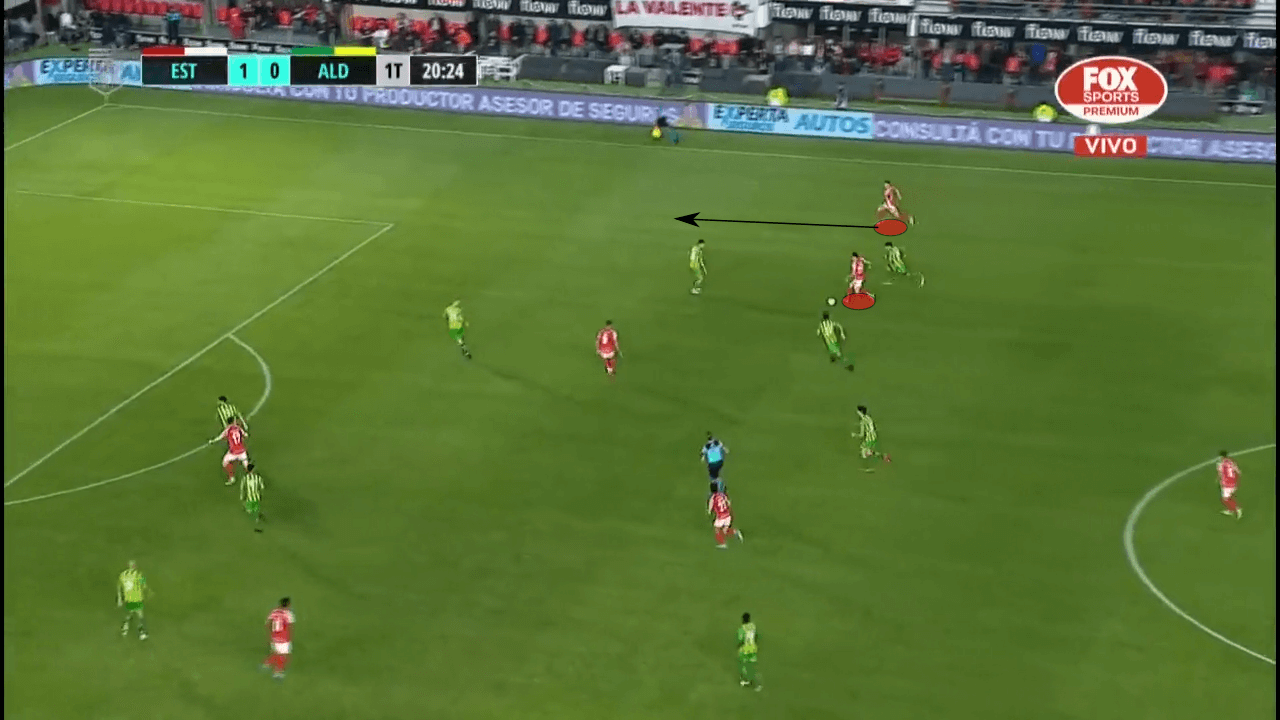
As in the build-up, adding a third man to the defensive line gives freedom to the fullbacks. This variation is also seen in the middle third and can be analysed below. One of the two midfielders drops to form a back three, only this time he is one of the wide players in an attempt to provide cover to the right-back. As he begins to drop back, the right-back starts to push up.
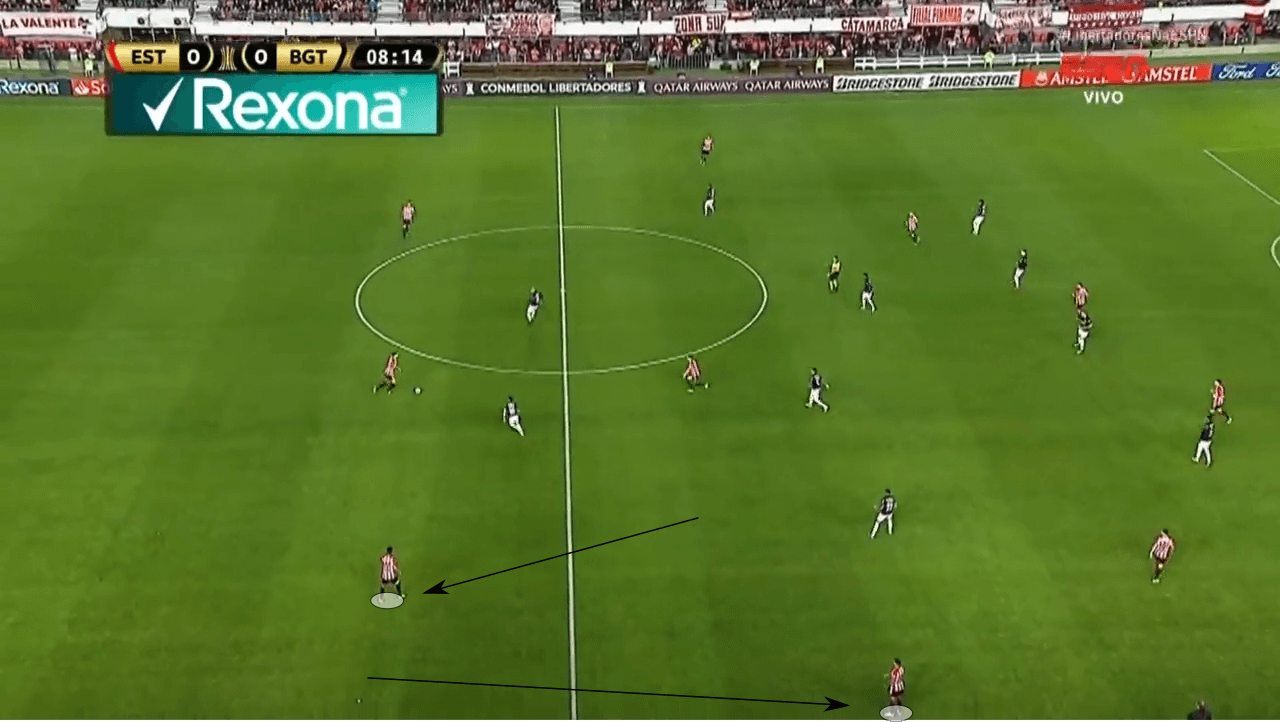
As this starts to take place, the right-winger begins to move into the half-space once again. By doing this, he drags the opposition fullback inside and leaves space for the right-back to push further up.
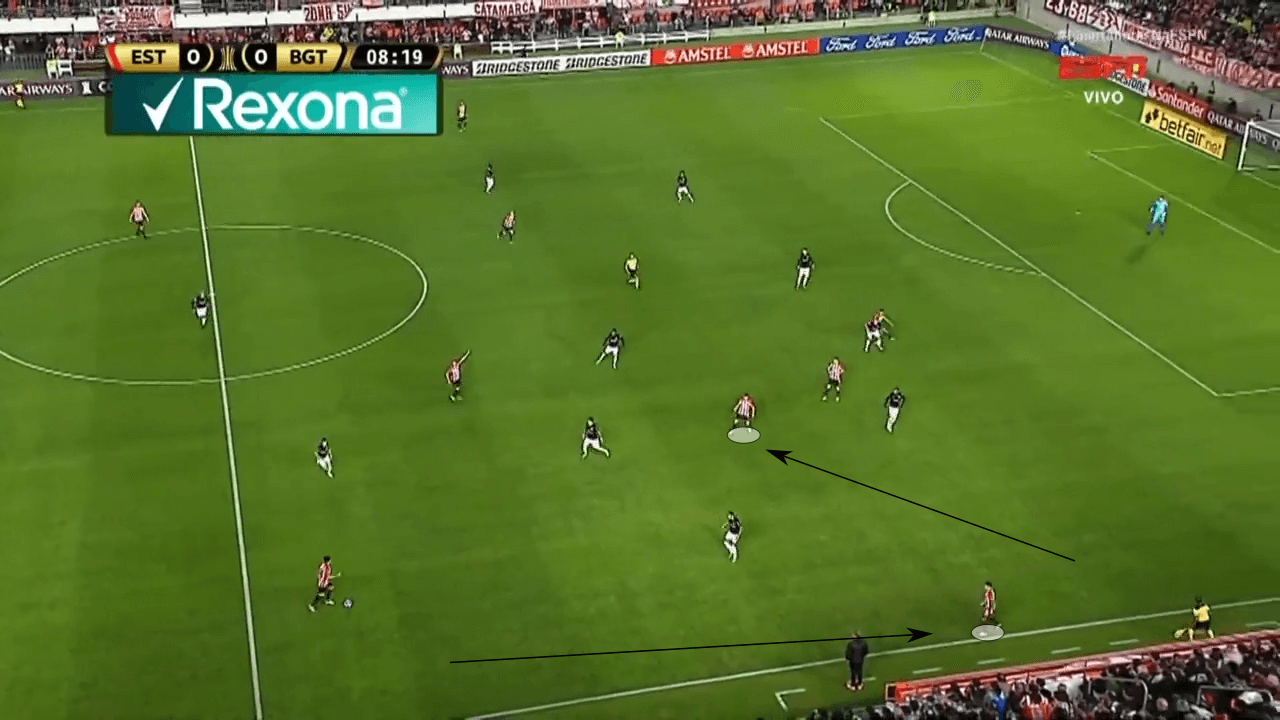
The midfielder who was providing cover now plays a ball up to the centre-forward, breaking two defensive lines with this pass. The centre-forward immediately plays it wide into space for the right-back, who is unmarked thanks to the winger’s movement. This sequence of movements allowed Estudiantes to manipulate the defensive organisation and progress from the middle third into the final third.
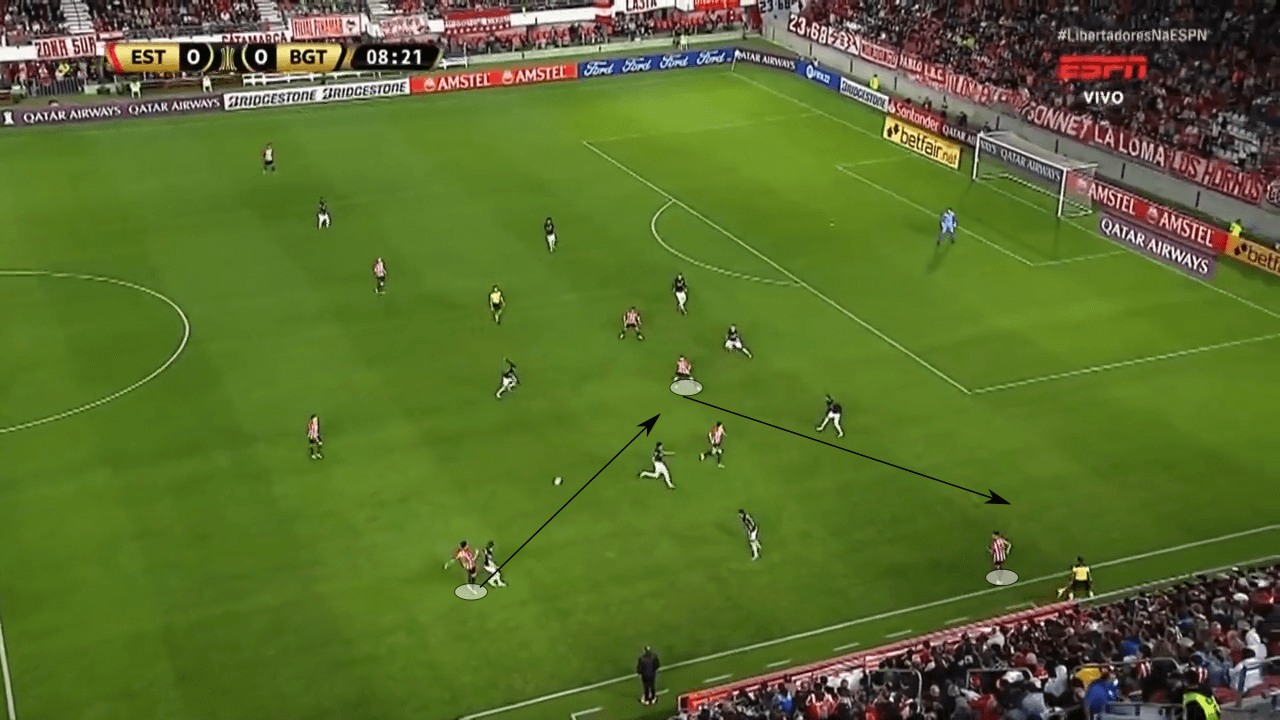
Another pattern that allows them to effectively break into the final third is the approximation of players. By constantly moving and providing options, Estudiantes’ players disorganise the defence and create spaces. In the example below, a player from higher up drops in to receive the ball.
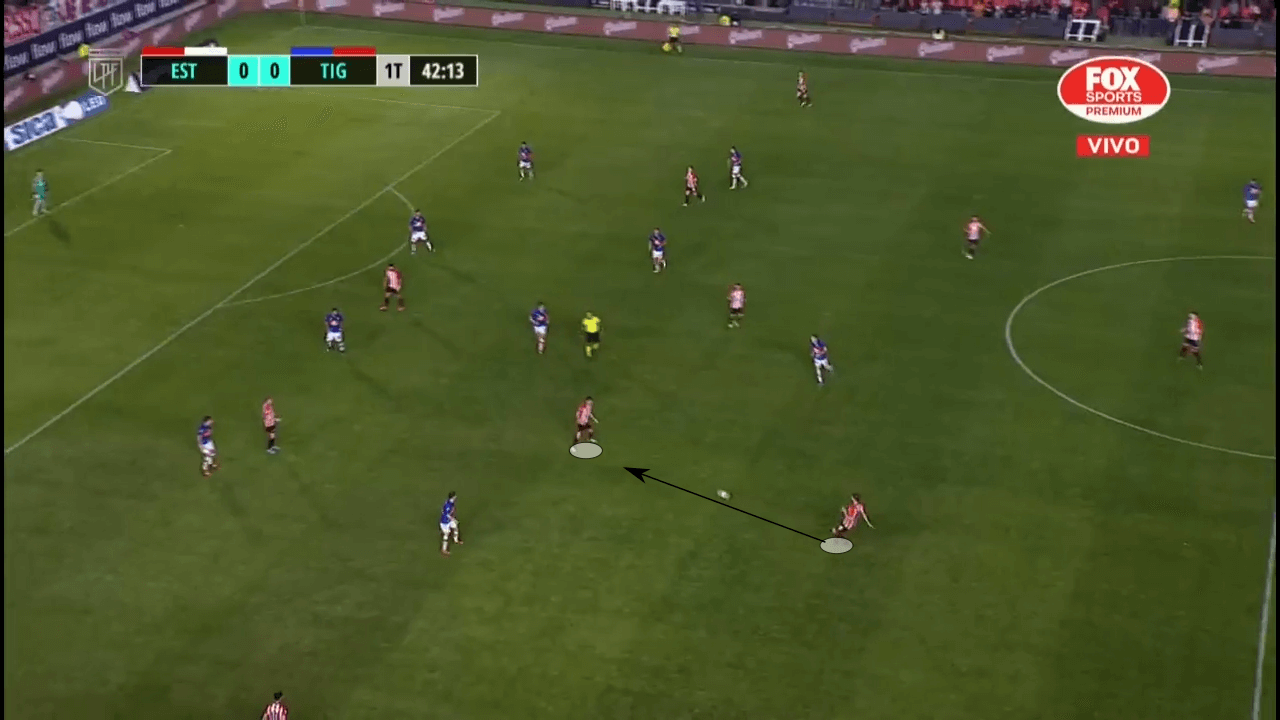
As the play progresses, they go outside to go back inside. By directing their play to the wide channel, they bring over three defenders. The space between these defenders and the rest of the defence is then exploited by a pass inside to the centre-forward who checks in. The constant checking in and conscious directing of play by Estudiantes’ players make them very effective in the attack.
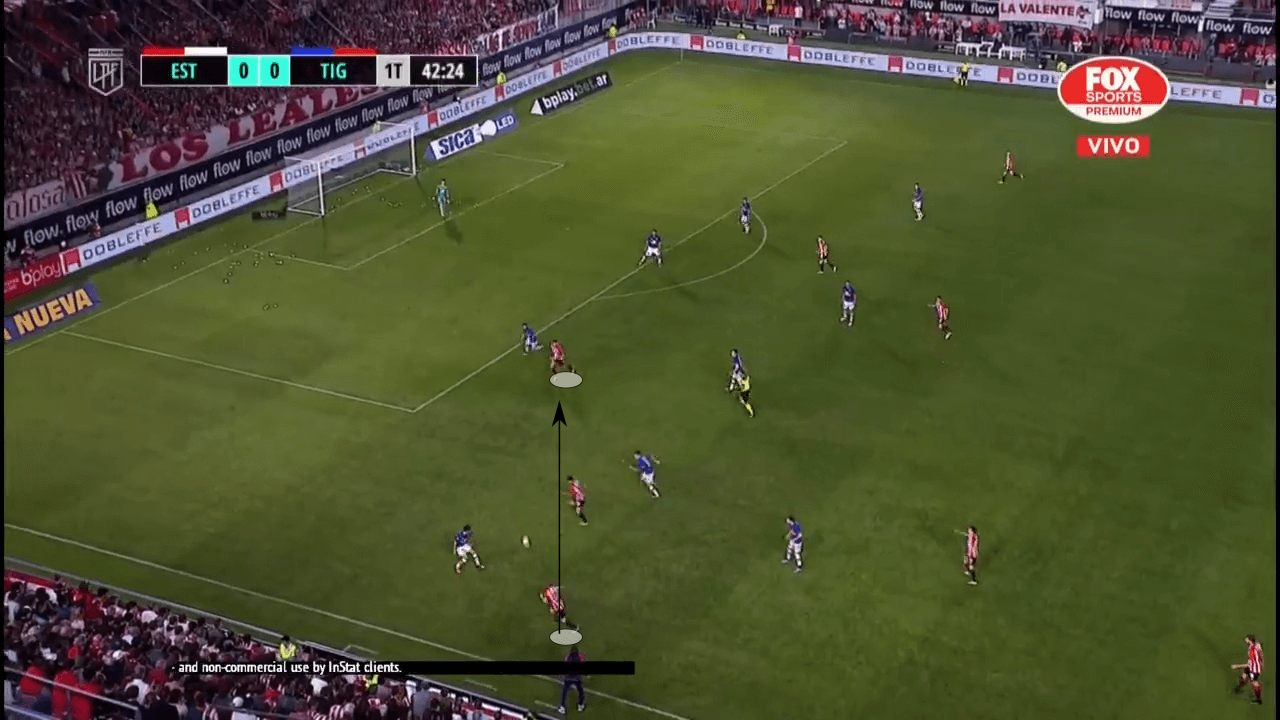
31-year-old Fernando Zuqui is the piece that allows the machine to function. The midfielder plays a key role in possession and is very important in moving the ball around and dictating play. In one of their recent matches, the many combinations he had with his teammates highlighted his importance. Notice how the most frequent combinations are not with the centre-backs, as commonly seen, but rather with his fullbacks and midfield partners.
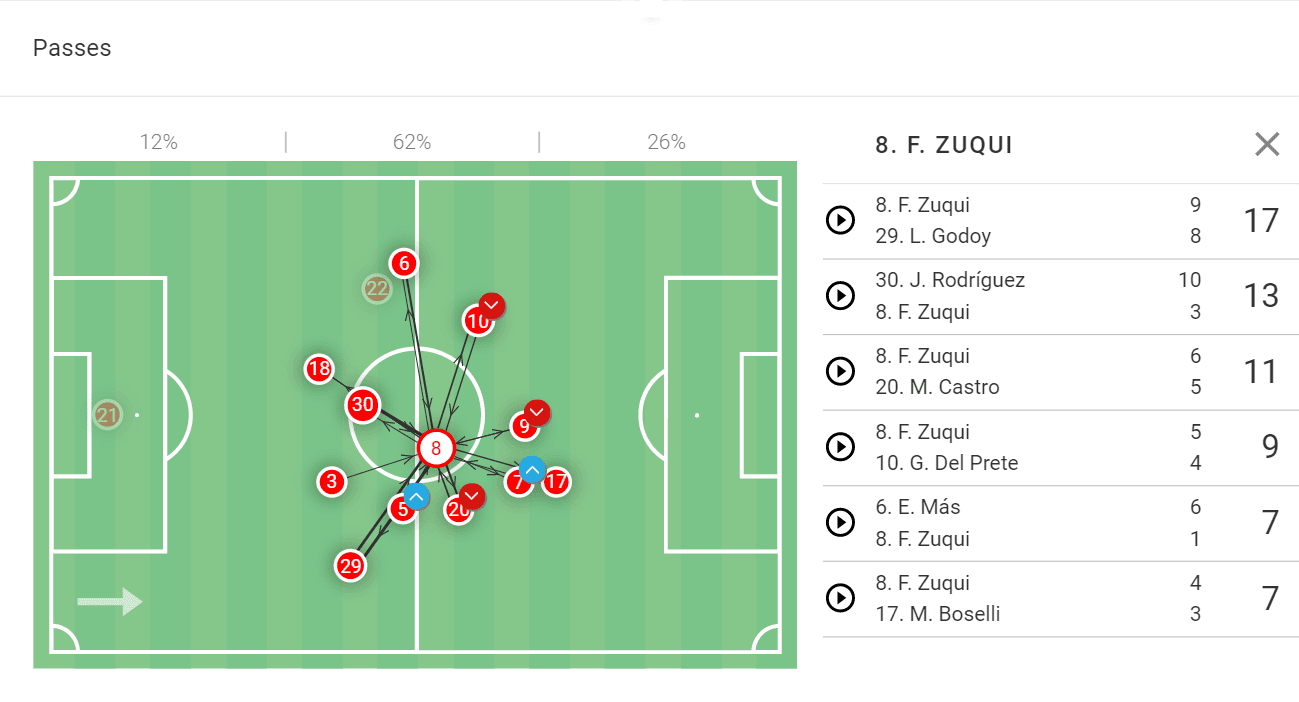
In the segment below, his role can be further illustrated. As the centre-back aims to begin play, the single pivot is tightly marked. Providing another option, Zuqui checks to receive the ball and immediately plays it wide.
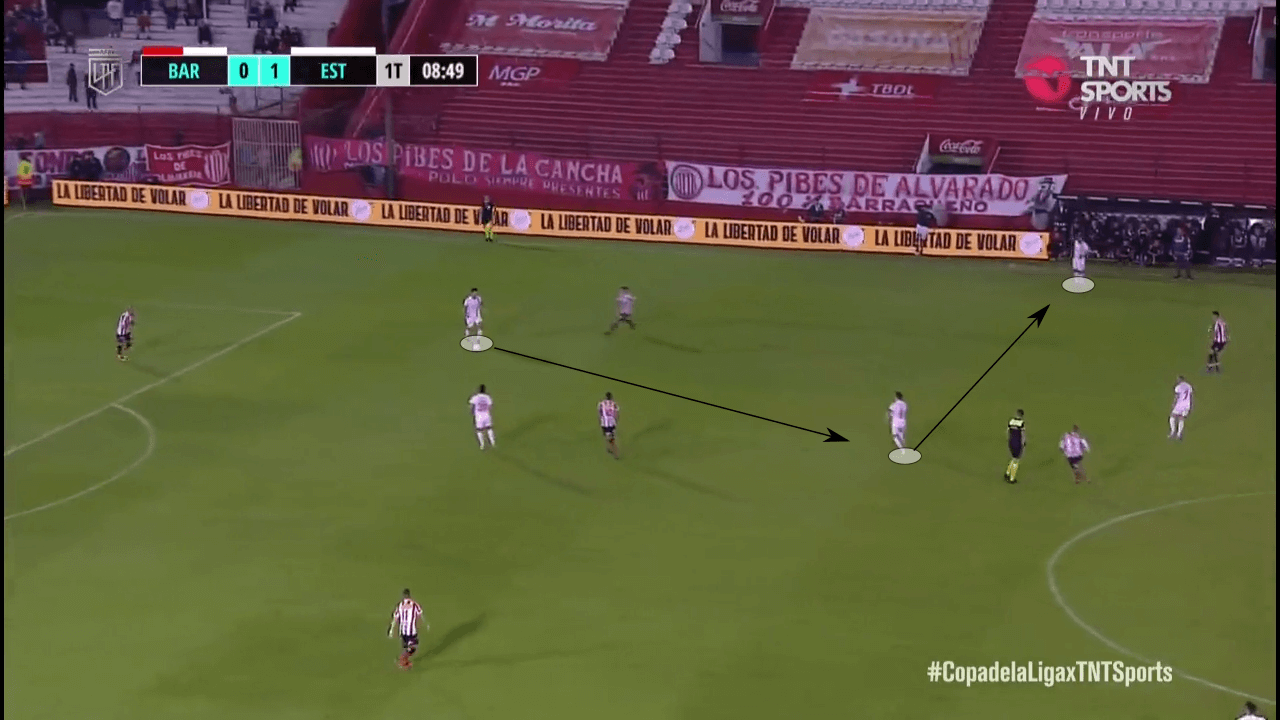
After playing it wide, he immediately checks again to provide an option. The wide player plays it back to him, and he plays a progressive pass to the wide player who is further up the pitch.
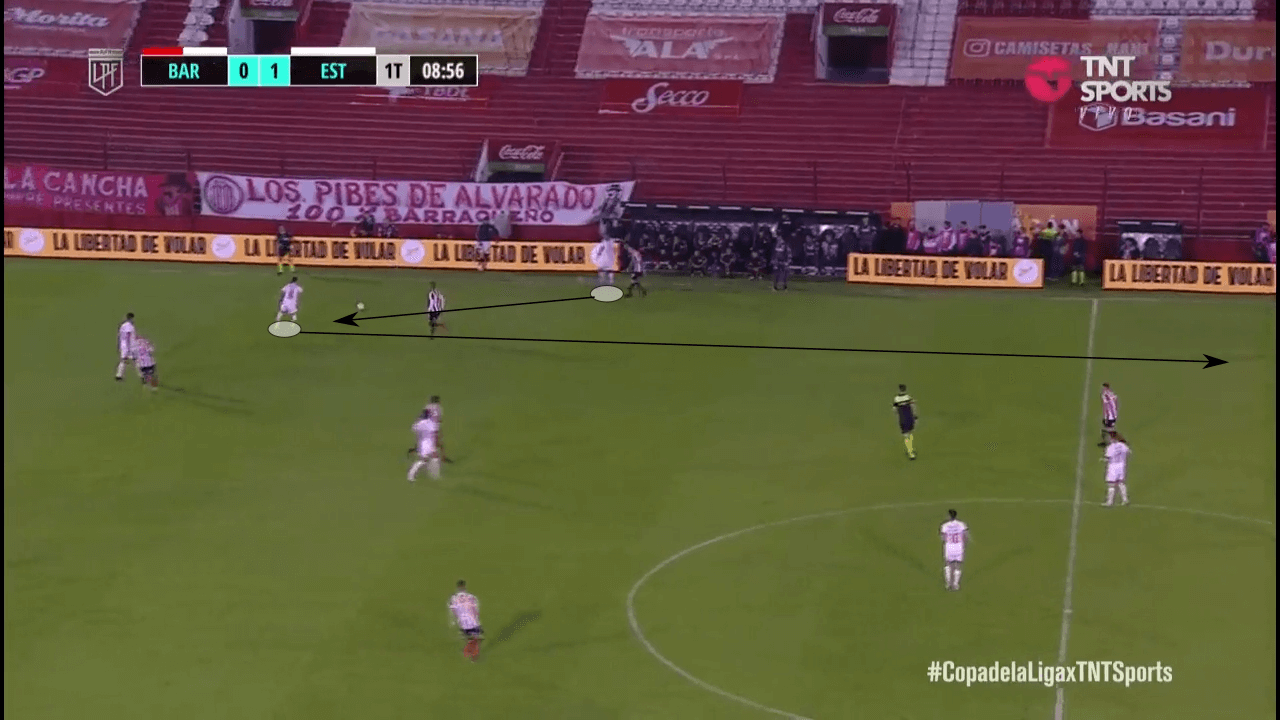
As the left-winger controls the ball and looks for support, the left-back immediately overlaps and attacks the depth. The winger plays it into space for the left-back in yet another example of how important the fullbacks are to the attack.
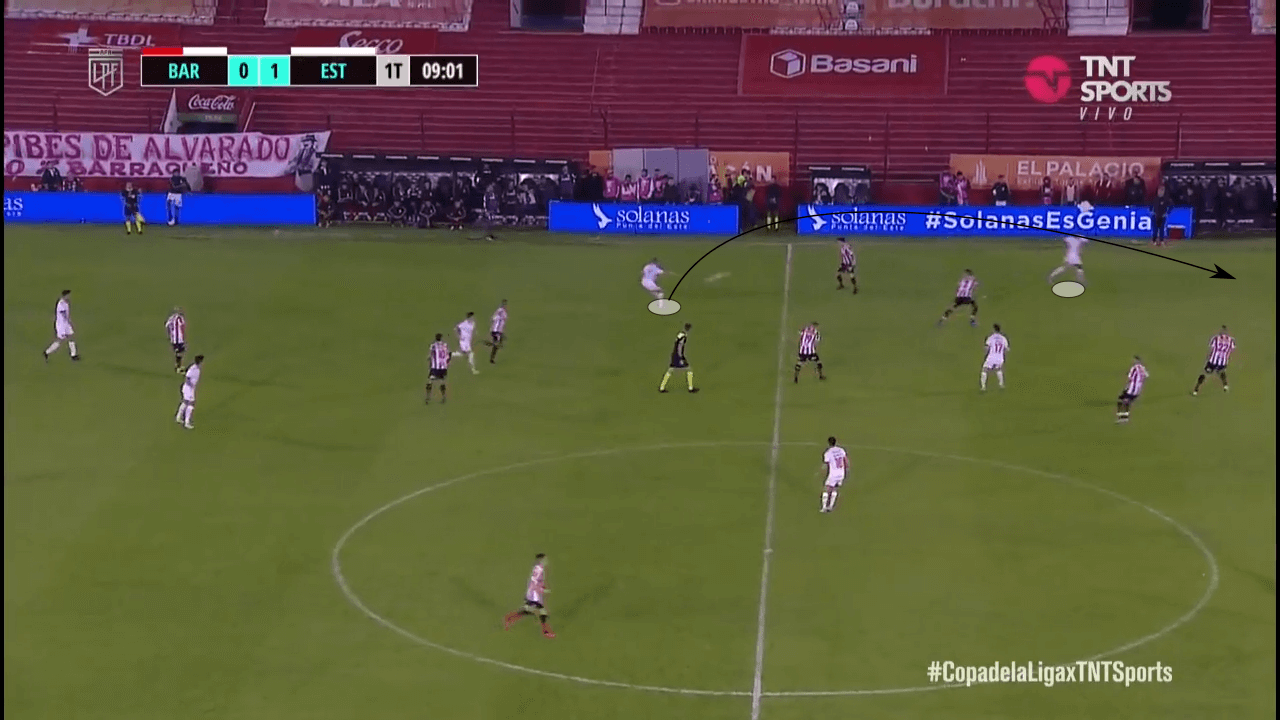
Chance creation
As we have seen in other phases of possession, a key characteristic of Estudiantes’ attack is constantly looking to break lines. In 2022, they average 129.42 forward passes compared to only 102.83 lateral passes. In their forward pass map, we are able to see how every player is involved in this principle.
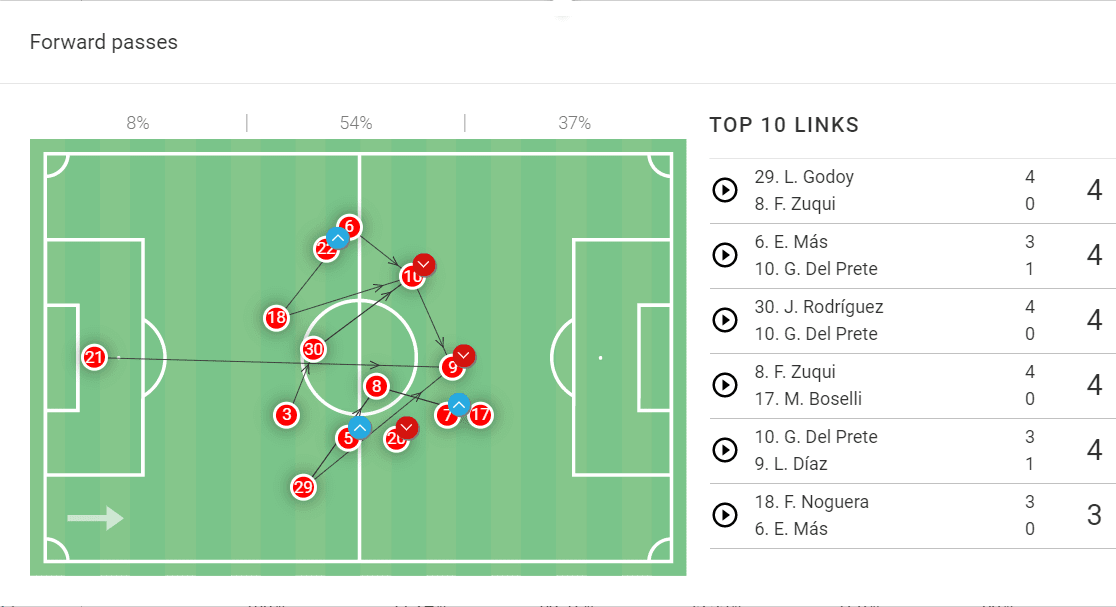
The image below illustrates this as the midfielder breaks the defensive midfield line by finding the centre-forward near the box.
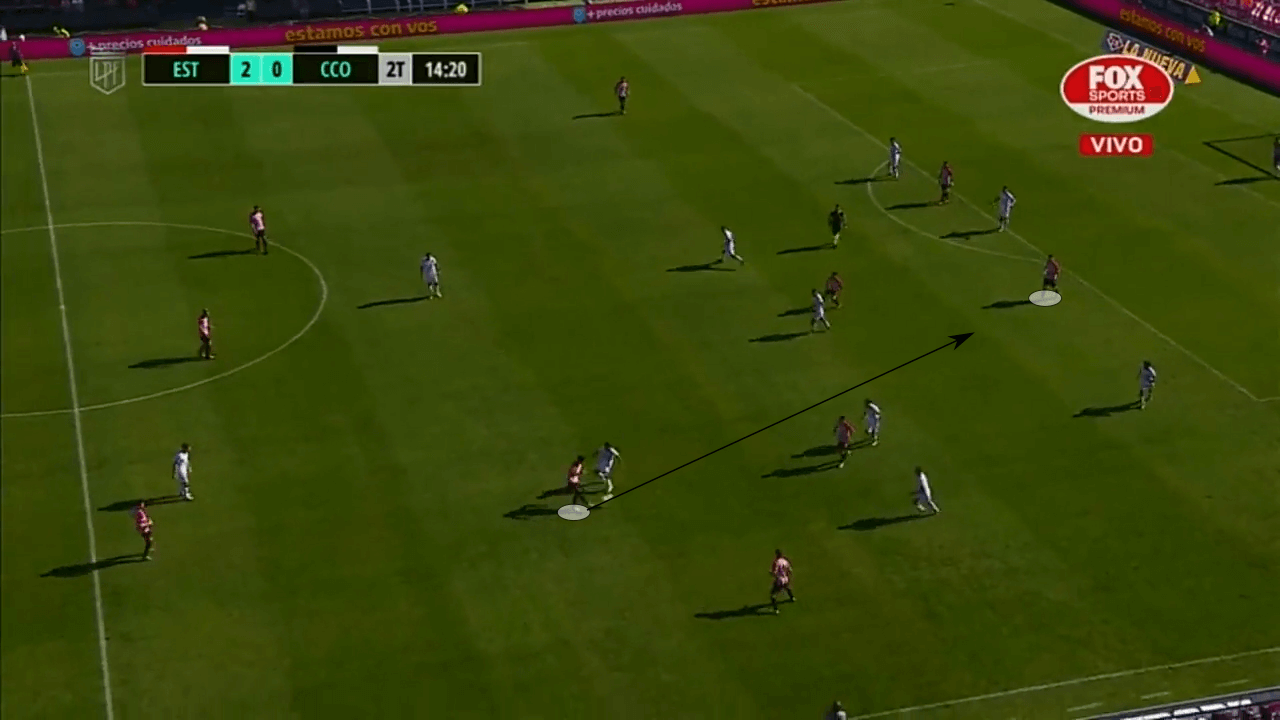
The centre-forward immediately lays off the midfielder coming from behind for a relatively good shot. Yet another example of the significance of checking in and immediately providing support.
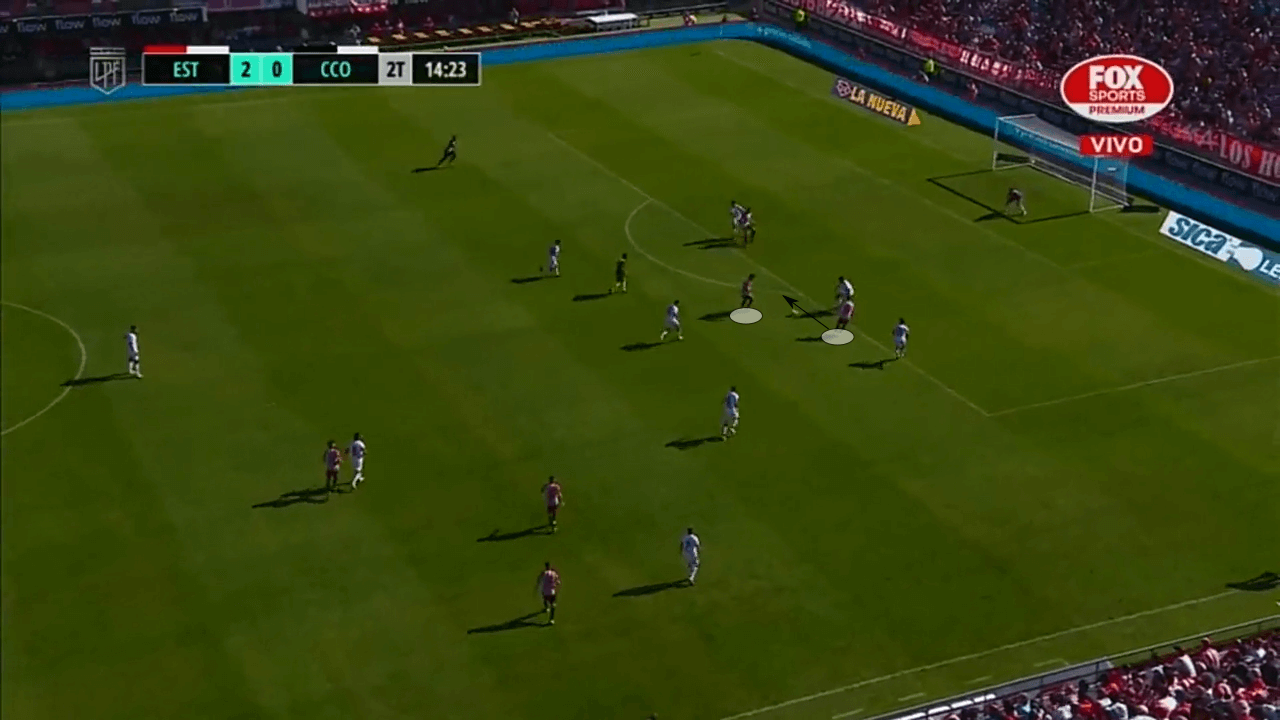
With this approach, through-balls are a significant and very effective characteristic of Zielinski’s side. In the example below, they take advantage of the disorganised defence in transition and play a through-pass centrally.
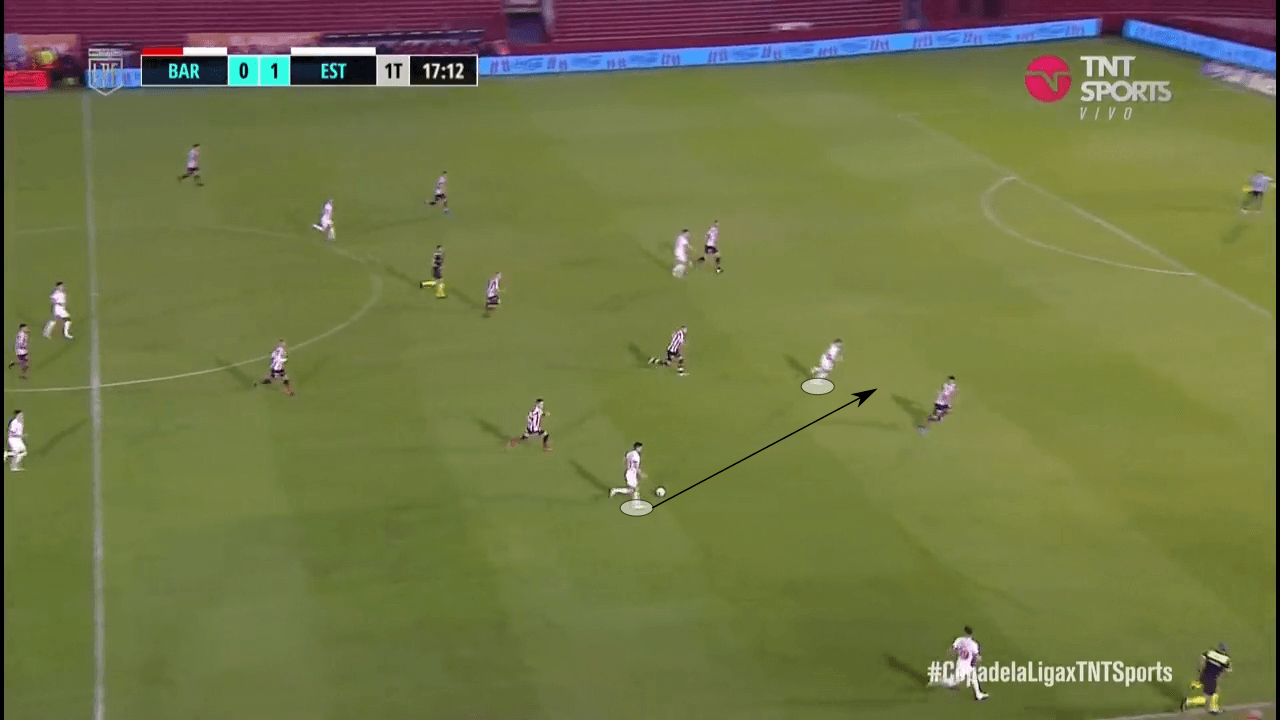
Another very good example shows the type of through-ball they prefer to play. Most often, these balls are in between two defenders for an oncoming forward toward the goal. The receiving player is often able to control it and immediately attack the goal.
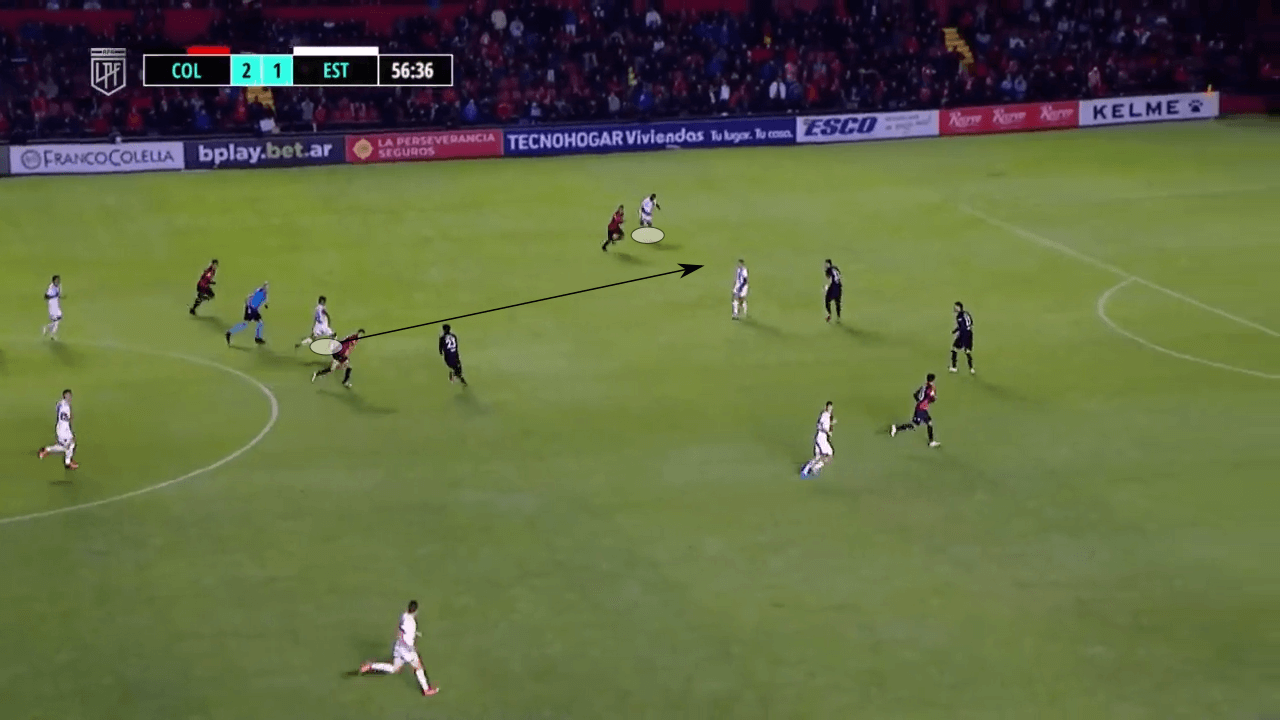
Another principle that allows Zielinski’s tactics to be effective is constantly attacking the depth. Players must constantly attack the space in an attempt to push the last defensive line deeper and create further space. This falls right in line with other attacking principles employed by Zielinski, especially playing direct and breaking lines. The example below illustrates the fullback making a run from deep into space. Again, movements by the winger and forwards disorganise the defence and create this space for the fullback to exploit.
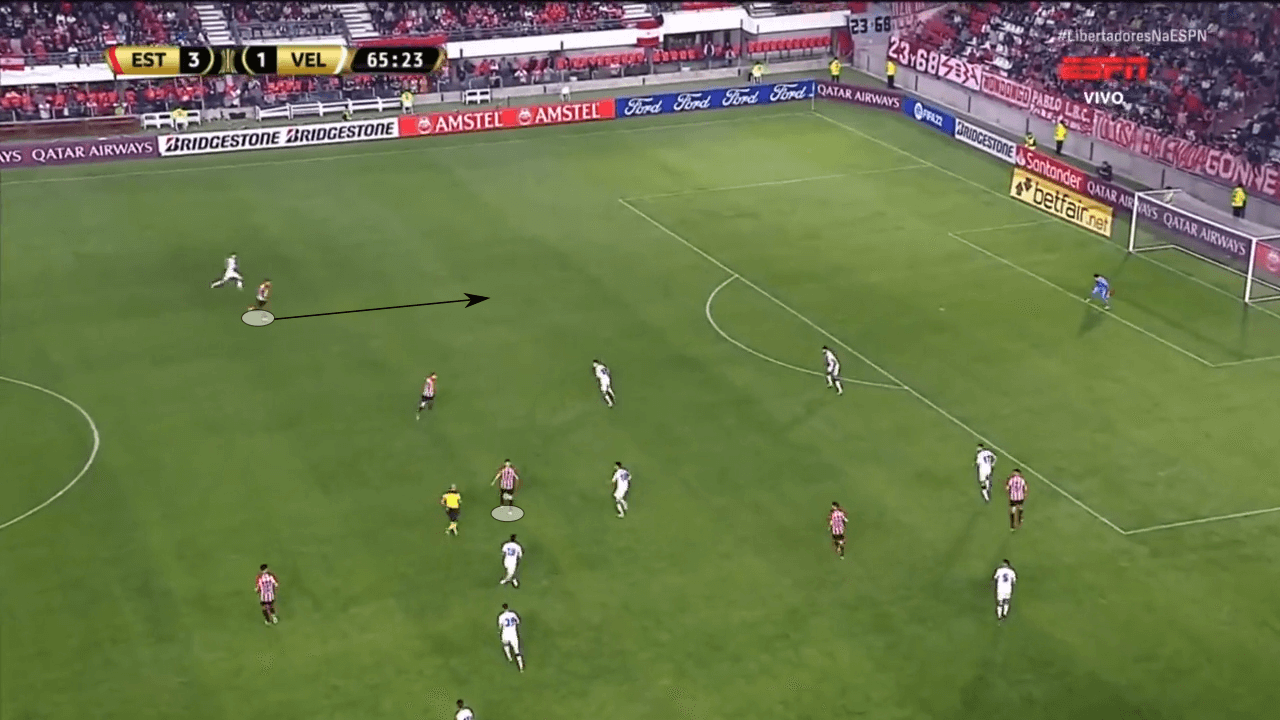
Now from inside, the forward makes a similar run in behind the last defensive line. The pass into space is effective and they are able to generate a chance, but even if the pass wasn’t made, the run would have still stretched the defensive line and created space.
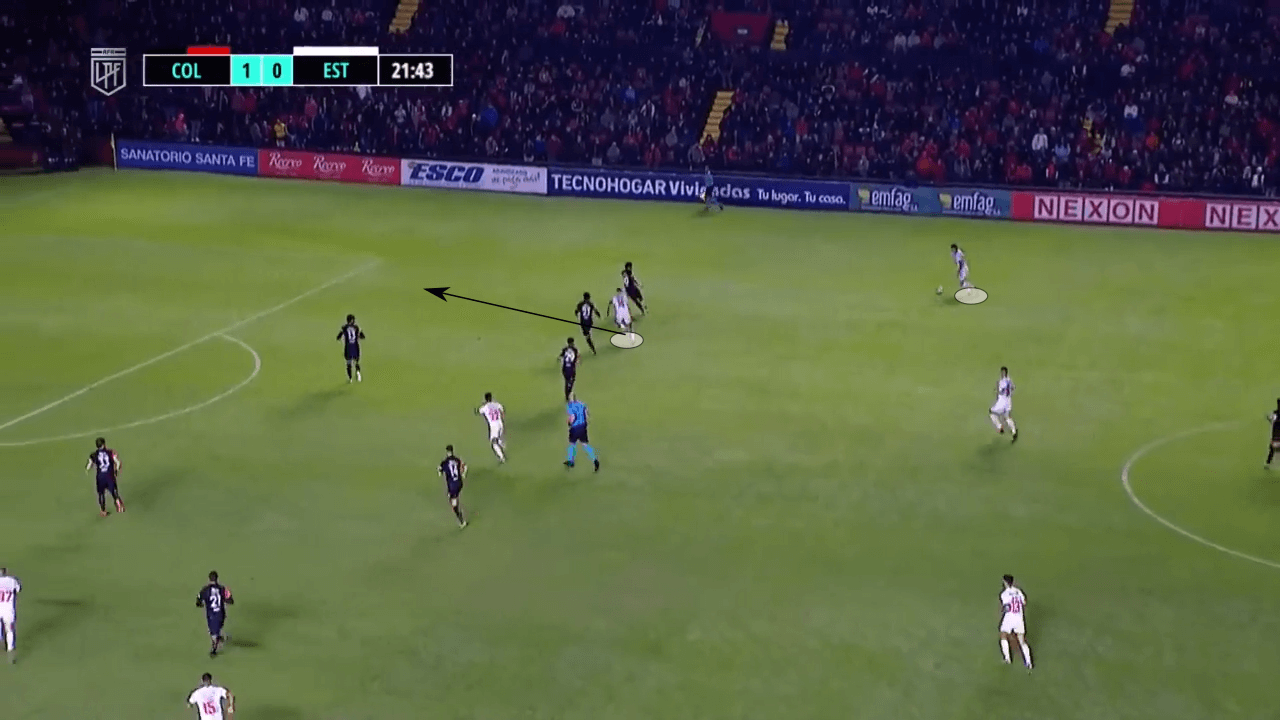
The receiving player is able to make a very good cross to the back post, but unfortunately, it did not result in a goal. Nonetheless, a very good chance was created.

Defensive organisation
While Estudiantes’ defensive numbers have not been necessarily bad, they are cause for concern. At 0.96 goals against per 90, their defence has been rather average. A further look at their xGA per 90 of 1.14 shows they still have been conceding high-quality chances. In this section, we look at their organisations in different phases of the defensive phase, and why they have been conceding high-quality chances.
First, their PPDA figure for 2022 stands at 8.94. In the Copa de la Liga, their PPDA of 8.28 is very close to the league average. They are not a team that constantly look press, but rather pick and choose their moments. When they do advance their press, they tend to be very effective at creating chaos and recovering the ball.
They choose when to press based on triggers. The most common one is the pass back. When the opposition makes a backward pass, they take advantage of the opportunity to advance the press and force the opposition further back. When they do this, they aim to maintain a man-marking press while still decreasing the pitch and congesting the playing area. They do so by cutting off the angles, so they do not have to necessarily stand next to a player to take them out of play. Below is an example of Estudiantes advancing their press after a pass back. After the pass, they advanced their defensive block and closed off most passing options.
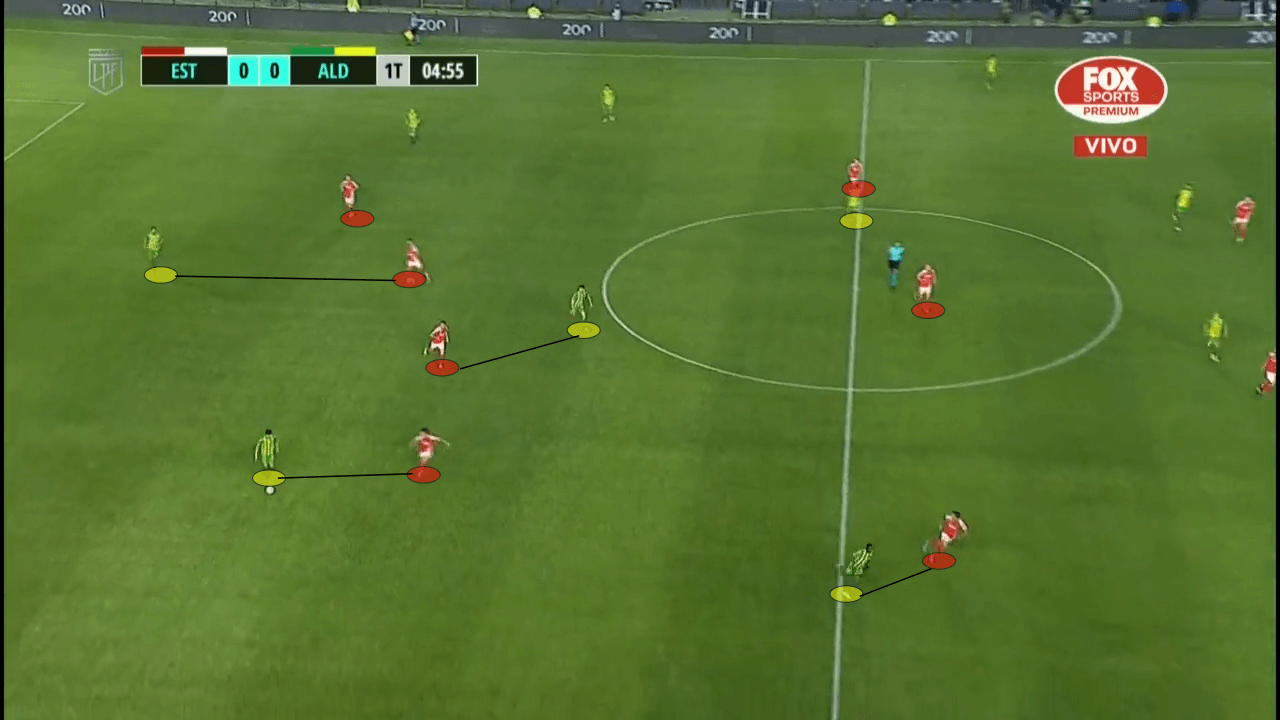
By closing off most passing options, they force another pass back and further advance their press with the same strategy of closing off angles and congesting the playing area.
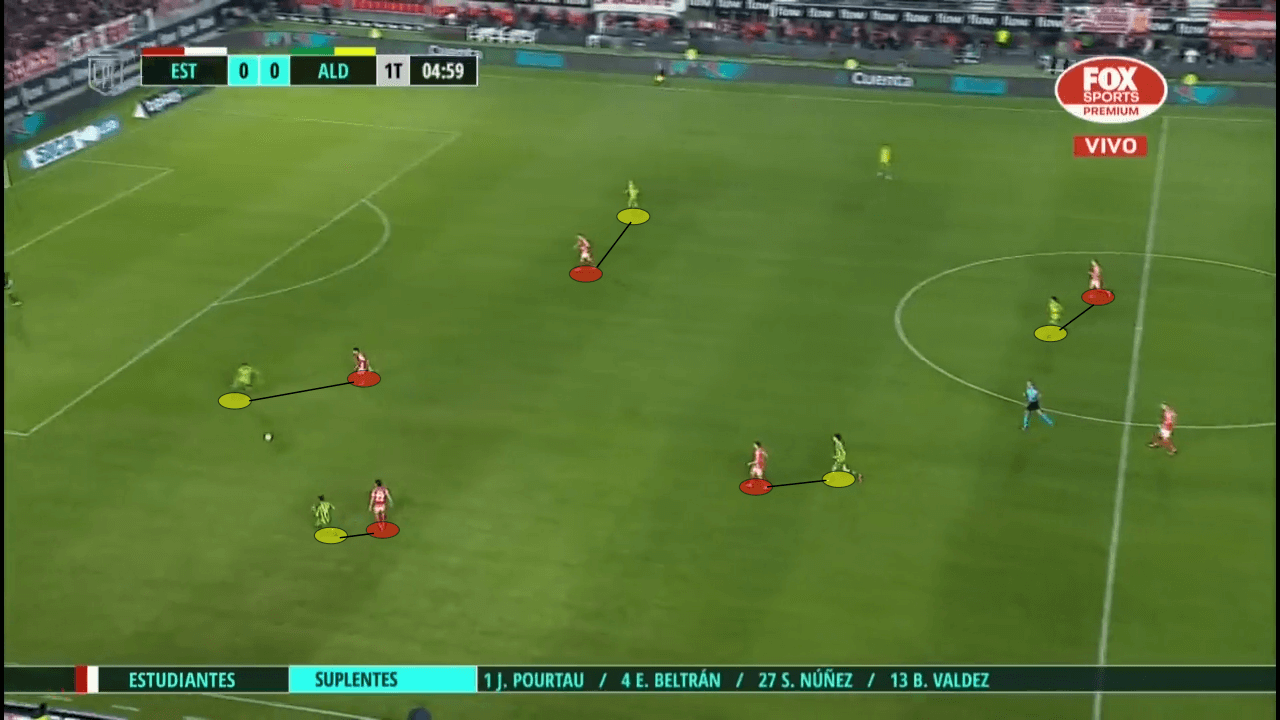
Occasionally, they will also look to high press from the opposition’s goal kick. In this scenario, they maintain a more clear man-marking approach as seen below against Bragantino.
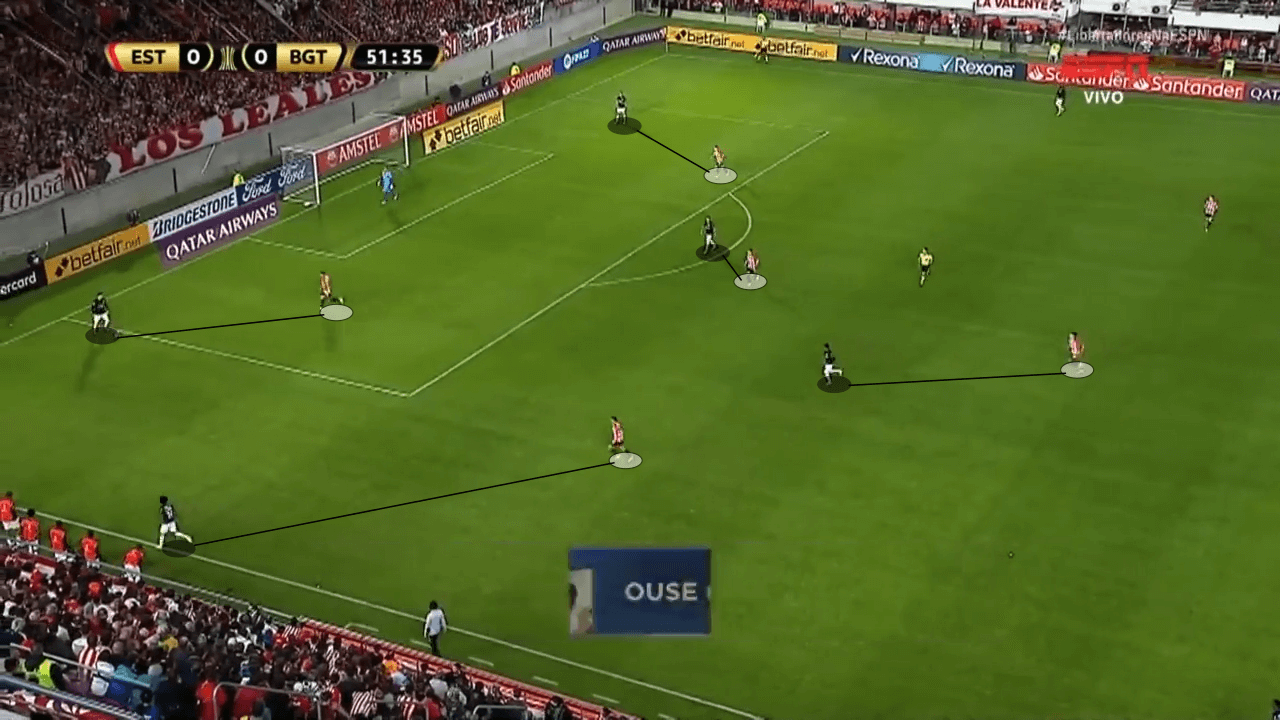
When they employ a high press, they tend to be very effective. However, their defensive problems lie in the lower blocks. Originally, they aim to organise in a 4-4-2, with the two blocks of four very compact.
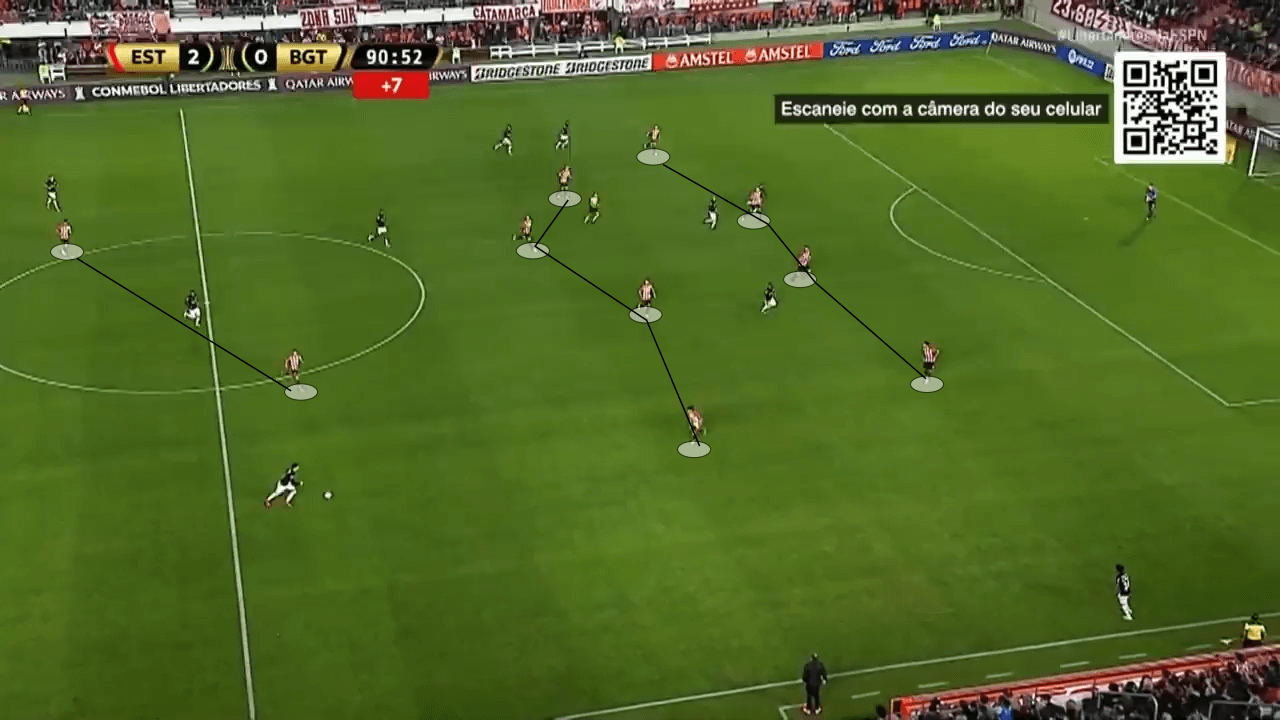
However, there are various scenarios where they struggle to reorganise this structure or simply maintain it. When this happens, players are at different lines and disconnected, allowing for a lot of space to be attacked. Below is an example where the far winger does not tuck in and leaves a lot of space between him and the next defender. The closest winger is also too advanced and leaves space open. A Bragantino player then occupies the space he is supposed to be at.
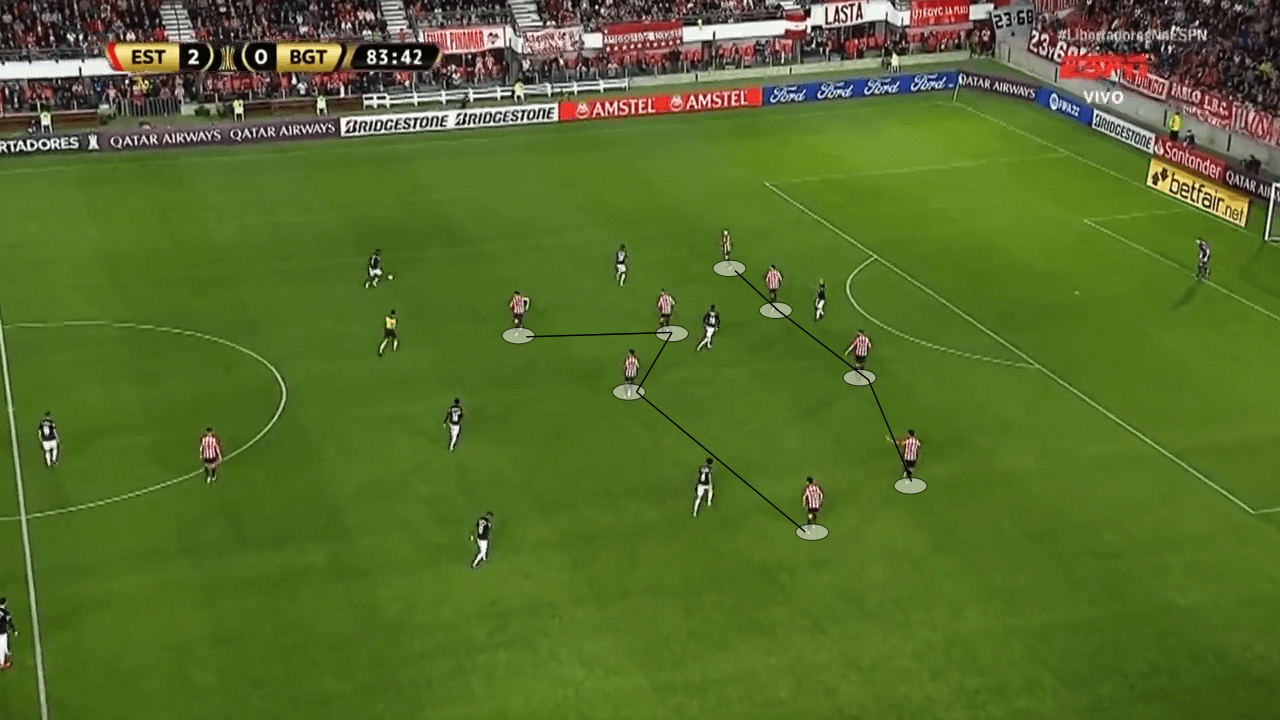
By failing to be in line with his teammates, the winger allows for a 2v1 in that area. The centre-back moves over in an attempt to cancel this out but drastically leaves a channel for Bragantino’s centre-forward, Ytalo, to receive the ball. The winger disconnecting from the defensive line sets off a chain of reactions which eventually turns into a very good chance for the opposition.
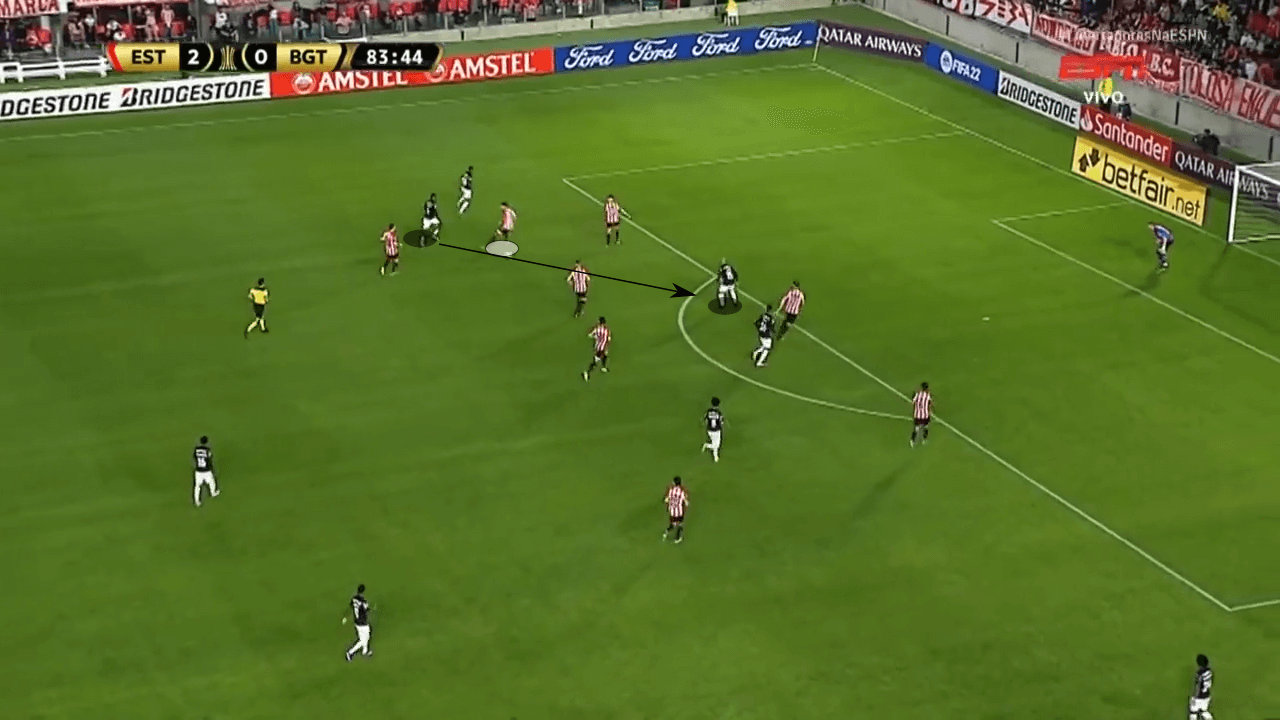
Additionally, this failure to remain organised and compact frequently leads to far too much space being left in important areas. In the instance below, they leave an incredible amount of space just outside the box for the opposition to exploit.
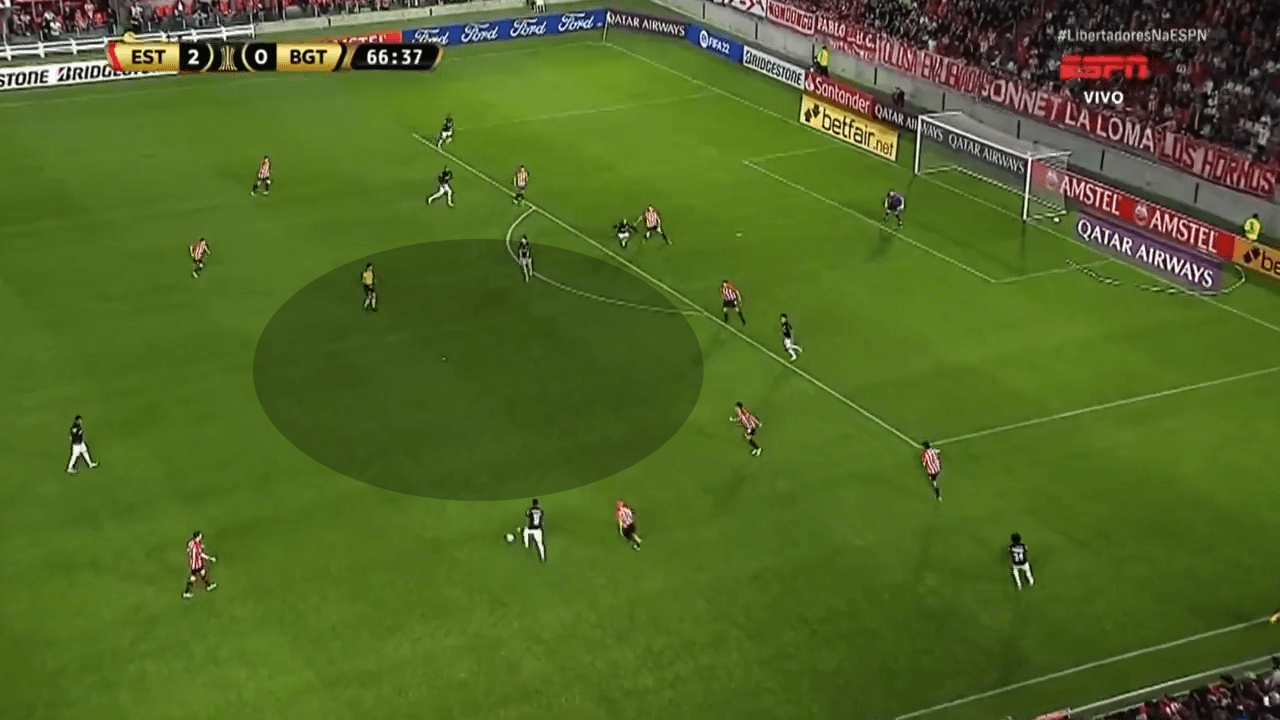
Another very similar example had taken place just a few seconds before.
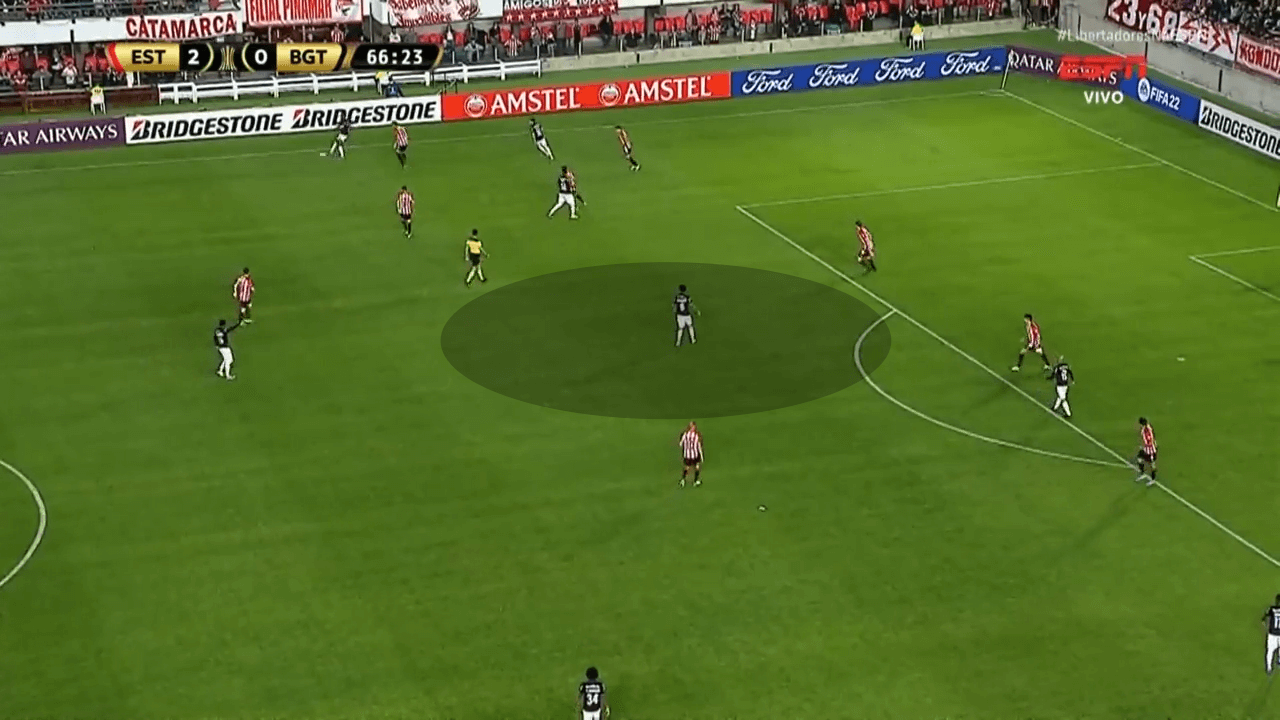
It is clear that when the opposition stretches the pitch and uses the wide areas, Estudiantes struggle to remain compact and consequently leave far too much space in crucial areas.
Conclusion
Estudiantes have been one of the best teams in South America in the first half of 2022. Both in the Copa de la Liga and in the Copa Libertadores, they have had extremely good starts. There are a few concerning factors such as how they will arrive later in the year fitness-wise, due to the demanding schedule. Their defence is also something that must be looked at and improved as conceding high-quality chances against the best teams may cost them dearly in the knockout phases. At any rate, they have demonstrated very good organisation and been very effective in performing Zielinski’s tactics, especially in the attack. Competing at the same level as star-filled squads such as River, Flamengo, and Palmeiras has definitely caught everyone’s attention, now the question is, will they maintain their form into the second half of the season?





Comments